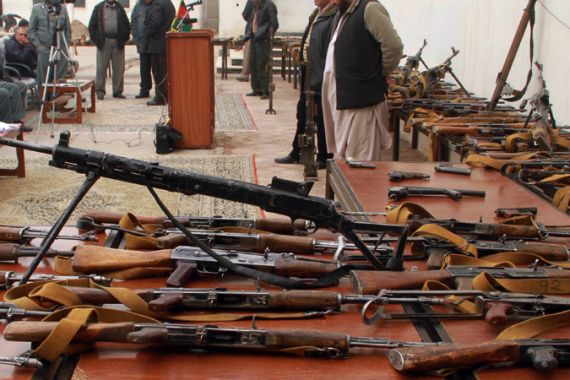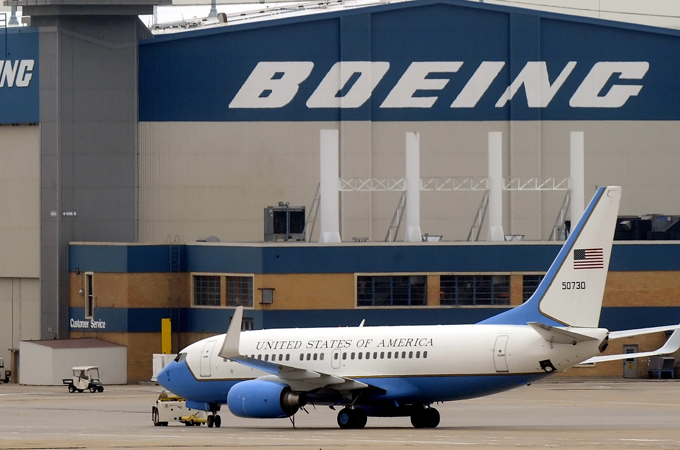The paradox of a ‘responsible’ arms maker
The negative impact of arms manufacture calls for a closer look at corporate social responsibility.

 |
| Despite being known as an aeroplane manufacturer, Boeing derives half its revenue from military contracts [EPA] |
Melbourne, Australia – This is the first in a three-part essay that explores an often neglected aspect of corporate responsibility: the paradox of being a “responsible” arms maker. The author argues that the “negative externalities” – or the impact on society – inherent in the deployment and threat of the use of weapons makes the standard of corporate responsibility difficult to apply. Instead, the author argue, those interested in corporate behaviour should view such firms through a “corporate social irresponsibility” lens, a strategy that identifies and allows a response to be made to normative developments, through proactive engagement and divestment strategies.
In this chapter, the author introduces the concept of corporate social irresponsibility. The next chapter will examine the current limits of the responsibility of arms makers, before the problem of institutional investment in cluster munitions producers is addressed in Part Three.
“War, mechanisation, mining and finance played into each other’s hands. Mining was the key industry that furnished the sinews of war and increased the metallic contents of the original capital hoard, the war chest; on the other hand, it furthered the industrialisation of arms, and enriched the financier by both processes. The uncertainty of both warfare and mining increased the possibilities for speculative gains: this provided a rich broth for the bacteria of finance to thrive on.”
Keep reading
list of 4 itemsIndia-Iran port deal: A gateway to Central Asia or a geostrategic headache?
India’s income inequality widens, should wealth be redistributed?
Facebook, Instagram face EU scrutiny over addictive effects on children
Lewis Mumford, Technics and Civilization, 1934
Proponents of the social responsibility of business and investment have seldom assessed the makers of conventional armaments such as machine guns, attack helicopters and battle tanks. Fewer still have attempted to devise and implement such programmes within firms, even though a growing number of civil society groups have begun to identify the entities involved – both directly and indirectly – in the development, production and investment of “controversial” weapons such as landmines and cluster bombs.
The prevailing argument is that arms makers and producers, as well as their financers, are not capable of being socially responsible due to three unique characteristics. First, the producers of arms are commonly viewed as agents of the state due to their importance in maintaining national sovereignty – rather than independent actors liable for the harm resulting from their products. Second, there is a belief that the manufacture of arms necessitates a higher degree of opaqueness than other industry groups, due to national defence considerations. Third, the state plays a dual – and sometimes conflicting – role as both the principal customer and regulator.
These three characteristics aside, I argue that the emerging concept of corporate social irresponsibility (CSI) proves far more useful in assessing arms makers’ limits of responsibility. By focusing on the negative externalities, we can examine the practice in the context of constitutive and regulatory norms, as opposed to those norms that are either moral or practical. Put another way, CSI effectively confines analysis to a relatively precise set of considerations, while a more traditional corporate social responsibility (CSR) approach requires choosing from a host of potential implementation strategies and activities. Thus, CSI provides a degree of specificity not offered by the more nebulous concept of CSR and actually complements existing CSR programmes and activities.
By arguing in favour of CSI’s value to institutional investors, I will address a seemingly large paradox: Can arms makers be socially responsible? This essay takes a small step towards answering that question, by examining the investment policies, practices and procedures of a handful of Australian pension and sovereign wealth funds in relation to investment in the development and production of cluster munitions – a class of weapon banned under international law since August 2010. The case selection is especially significant as the international Cluster Munitions Convention is the most ambitious disarmament and humanitarian treaty of the last ten years, and the Australian investment industry – with A$4tn ($4.0tn) in assets – is the fourth largest in the world.
Although no Australian firm is in the top 100 manufacturers of conventional weapons globally, Australian banking and financial institutions are among the largest investors in similar companies overseas. By focusing on the Australian experience, this chapter explores the “dilemma” institutional investors face when the positions of domestic governments do not explicitly prohibit direct and indirect investment as has happened in other markets, such as in New Zealand, the United Kingdom, Germany, France, Ireland, the Netherlands, Luxembourg, Belgium, Switzerland, Lebanon, Mexico, Norway and Rwanda.
Drawing on theoretical discussions in international relations and critical studies of corporate social responsibility, I find that the negative externalities inherent in armaments manufacturing demand that institutional investors view such firms through a “CSI lens”, especially when tasked with identifying and developing strategies to account for emerging social norms.
Characteristics of the armaments industry
The phrase “armaments industry” is a misnomer: It is not a distinct industrial sector, but rather a loose collection of firms operating in a number of disparate industry and sub-industry groups including aerospace and defence, electronics, semiconductors, information technology and shipbuilding. Very few companies operate solely for military purposes; they either derive a significant proportion of their revenue from civilian goods or producing “dual-use” components with both military and civilian applications.
Despite widespread arguments to the contrary, the marriage of the military and industry has been, in fact, an observed phenomena since 1897, when founder of the modern human rights movement, Jean Henri Dunant, predicted:
“Everything that makes up the pride of our civilisation will be at the service of war. Your electric railroads, your dirigibles, your submarines… telephones… and so many other wonderful inventions, will perform splendid service for war.”
|
“The US has not published a single document on its development and production of conventional armaments.” |
Today there are thousands of companies that may be classified as belonging to “armaments industry”, albeit to varying degrees and in a number of different ways. For example, Boeing is widely known as a manufacturer of commercial aircraft. However, the firm also derives around half of its A$60bn ($60.8bn) revenue from military contracts. These businesses are often structured so that individual firm’s suppliers, operations and functions are located in different states. As a result, it remains especially difficult for investors to identify and implement policies that require the targeting – either through exclusion or engagement – of specific stocks or sectors, as is usually done in responsible business and investment programs.
A number of national governments have begun disclosing high-level information on their domestic activity in this area. However, significant gaps in publicly available information remain. For instance, the US has not published a single document on its development and production of conventional armaments, despite having the highest level of government expenditure, the greatest volume and value of exports, and the largest number of private companies in the world. Instead, they have made some basic information about the scale and scope of the arms production available along with that of other major sectors in the Annual Industrial Capabilities Report to Congress.
Disclosure is slightly more forthcoming in parts of Europe, with the British and French publishing comprehensive stand-alone financial and employment data from 1992 and 1997 respectively. In the absence of regular reporting cycles, prior to a review of defence procurement in 2010, the Australian government most recently commissioned a survey of domestic activity in the mid-1990s as part of a broader strategic review.
In response, civil society groups and scholars have increasingly called for greater governmental and inter-governmental transparency through voluntary reporting instruments such as the Stockholm International Peace Research Institute’s (SIPRI), Arms Industry Database, or the UN Register of Conventional Arms. However, the information contained in these databases is incomplete and unverified; the responsibility of arms markers still must overcome a high degree of complexity and opaqueness when assessing the limits of responsibility of arms makers.
Read Part Two of this series: Arms makers and the limits of responsibility
Read Part Three of this series: What’s the harm of cluster munitions?
NAJ Taylor is a doctoral candidate in the School of Political Science and International Studies at the University of Queensland, and author of This Blog Harms.
Follow NAJ Taylor on Twitter: @najtaylor
The views expressed in this article are the author’s own and do not necessarily reflect Al Jazeera’s editorial policy.
